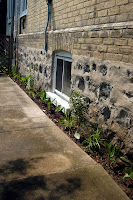An interesting thing about older homes (at least in my opinion) is the fact that over the years, as home heating systems changed and evolved, there is the likelihood that a fair number of different systems were used in providing heat to the house, both in the type of heat source and fuel burned, and in the method of heat delivery to the various parts of the house.
The Field House was constructed with 3 chimneys, so obviously wood stoves or fireplaces were used in the early days. There was also a large (2' by 2') square hole in the dining room floor, which has been filled in again, making me thing that a furnace or stove was used also in the basement, to provide a bit of central type heat to the main floor. In addition there was obviously at one point a hot water heating system with radiators, as there were a number of clues: a few cut off water pipes still show in the basement, there are tell-tale circular repairs in the wooden floors on the main level (a pair of 3" circles in each room), and the most obvious was the 800lb cast iron boiler installed in the 1940's which I tore apart and removed through the coal chute (oh yeah, and the two 150 gallon oil tanks in a corner of the basement!). Finally, the house was converted to a natural gas furnace with a forced air delivery system sometime in the 'eighties, which is the present system in use today.
The one slightly annoying thing about the forced air system is the fact that every room in the house has heat delivered to it by way of either a floor grate (main floor), or a grate in the baseboard (upper floor) except one, Alexander's bedroom. The challange of delivering heat to the second floor is that the heating conduit must be routed from the basement, then up a main floor wall such that on reaching the second floor it can easily be directed out a grate located in the base of the wall in the room to be heated. All fine and dandy when the first floor and second floor walls sit directly on top of one another, as a straight run of conduit can be run from the basement, through the floor, right up the first floor wall, through the second floor, and then out of a wall vent. Not so simple though, when the second floor wall does not sit directly on top of the first floor wall, or worse, there is no space in the wall to run a conduit because the wall contains a sliding pocket door. Such is the case with Alexander's bedroom, whose one wall is offset, and both walls beneath it contain pocket doors... the other two walls of his room are an exterior wall, or without room as it backs onto a staircase.














